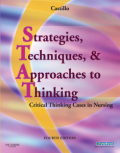
Strategies, techniques and approaches to thinking: critical thinking cases in nursing
Martínez del Castillo, Sandr
Designed to help beginning students develop critical thinking skills for nursing practice, this worktext presents over 80 realistic case studies and scenarios commonly encountered in the clinical setting. Using a straightforward approach and a variety of learning methods, it establishes a fundamental knowledgebase and reinforces key concepts and principles. Guiding you through the application, analysis, and synthesis of knowledge in clinical situations, you willalso learn how to integrate the nursing process as it applies to critical thinking. Covers timely issues such as delegation, prioritization, documentation/charting, and patient safety. INDICE: Section One - Cognitive-Building Critical Thinking ActivitiesProfessional Nursing PracticeVital SignsTemperaturePulseRespirationBlood PressureBody MechanicsHygieneInfection Control/Transmission of OrganismsSkin Integrity*CommunicationReporting Patient Status*Introduction to the Assessment ProcessBasic Physical AssessmentDocumentation*Self-ConceptCultural Aspects of NursingIntroduction to Formulating a Nursing DiagnosisFormulating a Nursing DiagnosisAssessment of the Elderly PatientCaring for the Surgical PatientWound AssessmentWound DressingsThe Patient with Fluid and Electrolyte ImbalanceElimination - UrinaryElimination - BowelGeneral NutritionGastrointestinal TractDiabetes MellitusComplication of Diabetes MellitusInsulin TherapyLegal Considerations in Nursing PracticeReview QuestionsSection Two - Priority-Setting and Decision-MakingActivitiesStandards of Professional PerformanceThe Patient Undergoing SurgeryThe Patient with an Intestinal ObstructionThe Patient with a ColostomyThe Patient with Colon CancerThe Patient with Total Parenteral NutritionThe Patient with Cirrhosis of the LiverThe Patient with Hepatic EncephalopathyThe Patient with Diabetes MellitusThe Patient Undergoing HemodialysisThe Patient with Peripheral Arterial DiseaseThe Patient with Chest PainThe Patient with Heart Failure*The Patient with a StrokeThe Patient with Chronic Obstructive Pulmonary DiseaseThe Patient with a Chest TubeThe Patient with UrosepsisThe Patient with a Transurethral Resection of the ProstateThe Patient Receiving a Blood TransfusionThe Patient with NeutropeniaThe Patient with a Hip FractureThe Patient with a Fractured TibiaThe Patient with Cataract SurgeryThe Patient with a Seizure DisorderThe Patient with a Do-Not-Resuscitate OrderLegal ConsiderationsSection Three - Applying the Critical Thinking ModelClinical Situation #1Clinical Situation #2Clinical Situation #3Clinical Situation #4Clinical Situation #5Clinical Situation #6Clinical Situation #7Clinical Situation #8Clinical Situation #9*Clinical Situation #10Clinical Situation #11Clinical Situation #12Clinical Situation #13Clinical Situation #14Clinical Situation #15Clinical Situation #16Clinical Situation #17Clinical Situation #18Clinical Situation #19Clinical Situation #20Clinical Situation #21 Clinical Situation #22 Section Four - Management and Leadership1. Working with Staff2. Dealing with Change3. Delegation and Problem-Solving4. Ethical Dilemma5. Professional Performance and Evaluation6. Working with a Culturally Diverse StaffSection Five - Applying Critical Thinking Skills to Test QuestionsSection Six - Quality Nursing Practice1. Situation #12. Situation #23. Situation #3Answer KeyBibliographyAppendix A - List of AbbreviationsAppendix B - List of Words and Phrases Commonly Used in the Book and Their Intended Meaning * Continuing case study included on Evolve
- ISBN: 978-1-4160-6152-6
- Editorial: Saunders
- Encuadernacion: Rústica
- Páginas: 280
- Fecha Publicación: 16/04/2009
- Nº Volúmenes: 1
- Idioma: Desconocido
